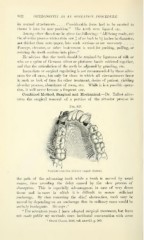Page 804 - My FlipBook
P. 804
802 ORTHODONTIA AS AN OPERATIVE PROCEDURE.
its normal attachnionts .... Considerable force had to be exerted to
thrust it into its new position." The teeth were lig:ated, etc.
Among other directions he gives the following: "All being ready, cut
the alveolar process with a thin saw \ of an inch to 1|^ inches in diameter,
not thicker than note-paper, into such sections as are necessary ....
P^orcej)s, elevator, or other instrument is used for pushing, pulling, or
rotating the tooth sections into pla(^e."
He advises that the teeth should be retained by ligatures of silk or
wire or a splint of German silver or platinum bands soldered together,
and that the articulation of the teeth be adjusted by grinding, etc.
Immediate or surgical regulating is not recommended by these advo-
cates for all cases, but only for those in which all circumstances favor
it, such as lack of time for other treatment, desire of patient, yielding
alveolar process, abundance of room, etc. While it is a possible opera-
tion, it will never become a frequent one.
Combined Method, Surgical and Mechanical.—Dr. Talbot advo-
cates the surgical removal of a portion of the alveolar process in
Fig. 833.
Surgical retraction of lower cuspids (Talbot).
the path of the advancing tooth while a tooth is moved by usual
means, thus avoiding the delay caused by the slow process of
absorption. This is especially advantageous in case of very dense
tissue and in cases in which it is difficult to secure sufficient
anchorage. By thus removing the chief obstruction, teeth may be
moved by depending on an anchorage that in ordinary cases would be
entirely inadequate. He says : ^
" For seventeen years I have adopted surgical treatment, but have
not made public my methods, since incidental conversation with some
* Dental Cosmos, 1896, vol. xxxviii. p. 909.


